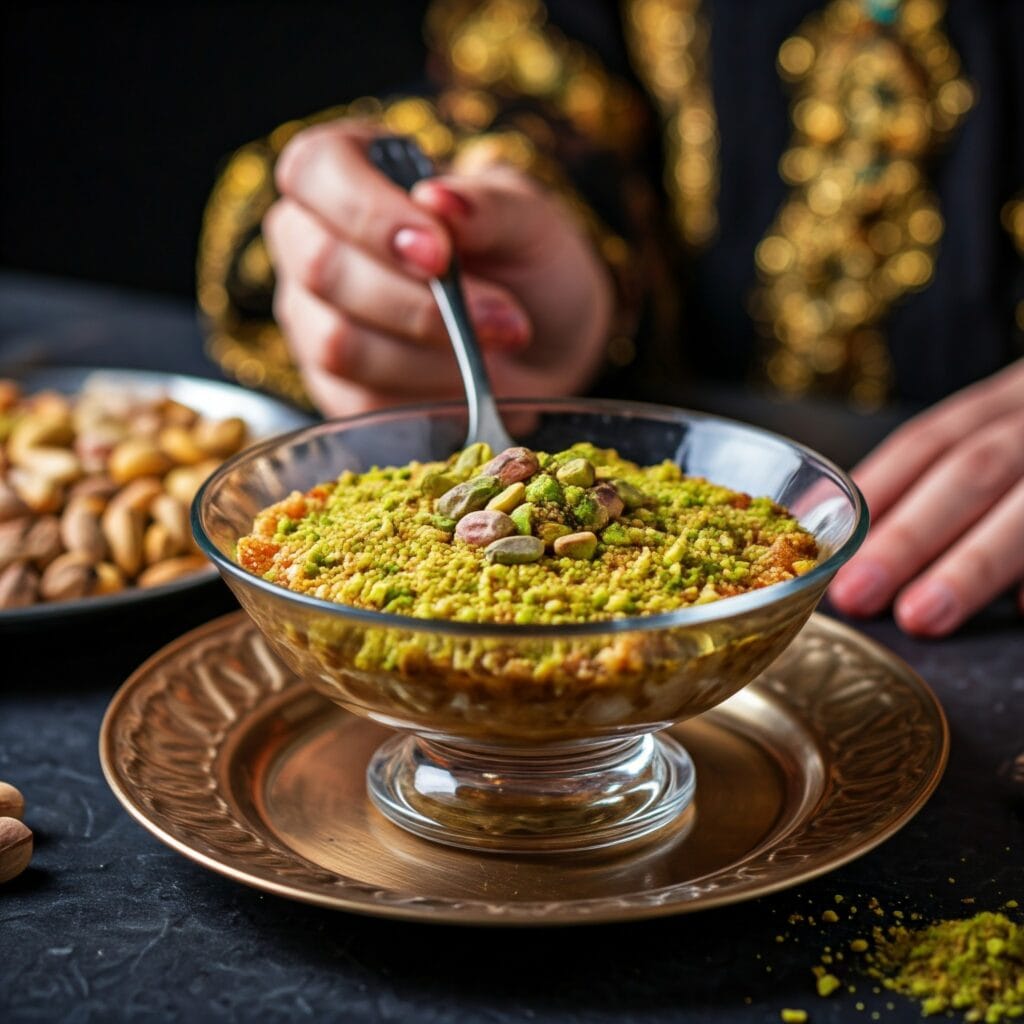Muhalabieh, a delightful and creamy dessert, is much more significant in Middle Eastern culture than just being a sweet treat. What is the cultural significance of Muhalabieh? This question unveils a deeper story about the rich traditions and sense of identity tied to this beloved dish. A perfect blend of history, hospitality, and celebration, Muhalabieh has been passed down for generations, cherished for its taste and connection to cultural values.
In this article, we will explore Muhalabieh’s cultural significance in depth. From its ancient origins to its place in modern Middle Eastern society, we’ll uncover why this dish remains a symbol of togetherness, tradition, and cultural pride. Whether served during family gatherings, religious celebrations, or simply as a comforting dish, Muhalabieh’s importance extends far beyond its sweet and delicate flavour.
What Is Muhalabieh?
Muhalabieh is a traditional Middle Eastern dessert that is creamy, smooth, and often flavoured with rose water or orange blossom. This sweet treat is typically made from milk, sugar, and rice flour, which thickens to a pudding-like consistency. Some variations also include nuts such as pistachios or almonds for added texture and
flavour.
While its exact origin is debated, Muhalabieh is widely believed to have originated in the Middle East, with roots that can be traced back to ancient civilizations like the Persians and the Ottomans. Over time, it has evolved in different regions, each adding its unique twist, yet the fundamental recipe and cultural importance have remained intact.
The cultural significance of Muhalabieh lies in its symbolism of hospitality and family. In many Middle Eastern countries, preparing and sharing Muhalabieh is a gesture of care and respect. It brings people together during special occasions, from Ramadan to weddings, and even during casual family meals.
The Historical Origins of Muhalabieh
To truly understand Muhalabieh’s cultural significance, we must first delve into its origins. Historians suggest that Muhalabieh’s roots go back to the ancient civilizations of the Middle East, especially in regions once under the influence of the Ottoman Empire and the Persians. Early recipes for the dessert were relatively simple, often prepared with just milk and sugar.
Throughout history, Muhalabieh has been a symbol of hospitality. In Ottoman times, it was common for hosts to serve guests this dish as part of a lavish meal, ensuring that the guests felt honoured and respected. The dish was often made with ingredients that were not only readily available but also carried health benefits, which is one reason it was favoured during critical cultural events.
As the centuries passed, Muhalabieh became more than just a dessert—it became a part of the cultural fabric of Middle Eastern life. Its evolution continued with various regional additions, such as rose water, almonds, and pistachios, now common ingredients. This transformation showcases how food traditions evolved yet still hold cultural significance.
Muhalabieh in Middle Eastern Culture

What is the cultural significance of Muhalabieh in Middle Eastern society? Beyond being a delicious treat, it represents a connection to one’s roots. The dessert symbolizes family, hospitality, and celebration in the region.
In Middle Eastern culture, food is never just about nourishment; it’s an experience that bonds people. Muhalabieh is frequently prepared for significant celebrations such as weddings, religious festivals like Ramadan, and family gatherings. Its presence on the table signals joy and togetherness, making it a cherished dish that reinforces the importance of family and community.
During Ramadan, for example, Muhalabieh often marks the end of a long day of fasting. The dessert is served to break the fast, providing a sweet and cooling end to the evening meal. Its significance is not just in the food itself but in the surrounding rituals—shared among family members and guests, Muhalabieh fosters a sense of unity and joy.
Muhalabieh as a Symbol of Heritage
One of the most profound aspects of Muhalabieh’s cultural significance is its role in preserving cultural heritage. As a dish passed down through generations, it bridges the past and present, connecting modern-day individuals to their ancestors. Families pass down recipes and cooking techniques, ensuring that the history and cultural importance of Muhalabieh lives on.
In many Middle Eastern households, making Muhalabieh is not just a cooking task; it’s an opportunity to gather as a family and share stories. Older generations teach the younger ones, keeping traditions alive while infusing new ideas and flavours. This continuity creates a bond that transcends the dessert itself, reinforcing the values of love, respect, and heritage within the family unit.
Moreover, the ingredients used in Muhalabieh—milk, rice flour, and natural flavourings—have deep ties to the region’s agricultural practices. These ingredients are part of the culinary tradition and represent the region’s connection to the land, making the dessert a symbol of agrarian heritage.
The Role of Muhalabieh in Social Gatherings
What is the cultural significance of Muhalabieh in social gatherings? It plays a central role in Middle Eastern hospitality and social life. Serving Muhalabieh during gatherings is a way to show care and generosity, reflecting the importance of sharing in Middle Eastern culture.
When guests arrive, particularly in Middle Eastern homes, food is one of the first ways to make them feel welcome. Muhalabieh, with its creamy texture and rich flavour, is a go-to choice for such occasions. Whether it’s a casual family get-together or a large community celebration, Muhalabieh is often prepared to ensure everyone feels appreciated and included.
In these settings, the dessert is more than just food; it symbolizes the host’s warmth and desire to share. It creates an atmosphere of relaxation where people can connect, share stories, and bond over a sweet, familiar taste.
Muhalabieh and the Middle Eastern Table: A Culinary Tradition
When considering Muhalabieh’s cultural significance, it is essential to place it within the broader context of Middle Eastern cuisine. This region’s food culture is known for its diversity, use of fresh ingredients, and unique flavors, and Muhalabieh is no exception. It complements other dishes, offering a sweet contrast to the savoury courses.
Often served alongside other traditional foods like kebabs, pilafs, and hummus, Muhalabieh balances the meal with its delicate sweetness. Its role in the meal is also symbolic, offering a satisfying end to a feast. The gentle, comforting dessert is the perfect finale for a gathering centred around food, family, and friendship.
Health Benefits of Muhalabieh
Though often viewed as a sweet indulgence, Muhalabieh also has health benefits that add to its cultural significance. The ingredients—milk, rice flour, and sugar—are simple yet nourishing. Milk is a rich source of calcium, while rice flour provides a gentle, easily digestible carbohydrate. Additionally, many variations of Muhalabieh are made with rose water, which is believed to have soothing properties for the digestive system.
Moreover, the dessert is often made with nuts such as pistachios or almonds packed with healthy fats and proteins. This adds an extra nutritional boost, making it a treat for the tastebuds and a functional part of the meal. Despite its sweet nature, Muhalabieh can be a beneficial part of a balanced diet when consumed in moderation.
Modern Adaptations of Muhalabieh
In today’s world, food is constantly evolving. The cultural significance of Muhalabieh remains strong, but the dessert is also experiencing modern adaptations. Chefs and home cooks are experimenting with new ingredients, textures, and presentations. From adding exotic fruits like mango to serving it in stylish glasses or jars, modern Muhalabieh is as much about creativity as it is about tradition.
Some even make Muhalabieh vegan-friendly by substituting milk with plant-based alternatives like almond or coconut milk. These adaptations ensure that Muhalabieh can continue to be enjoyed by future generations, regardless of dietary restrictions.
Why Muhalabieh Continues to Hold Cultural Significance
So, what is Muhalabieh’s cultural significance in the modern day? The answer lies in its ability to bring people together. Despite the changes in society and cuisine, the essence of Muhalabieh remains unchanged—it is still a symbol of care, tradition, and connection. Whether served at a family dinner, a wedding or as part of a Ramadan feast, it is essential in creating moments of joy and togetherness.
Sharing this dessert fosters relationships, celebrates culture, and preserves the Middle East’s heritage. As generations pass, Muhalabieh’s cultural significance grows, reminding people of the importance of food in shaping identity and building community.
Conclusion
The cultural significance of Muhalabieh is undeniable. From its origins in ancient times to its place in modern Middle Eastern culture, this dessert remains a beloved symbol of tradition, hospitality, and family. Whether enjoyed during festive occasions or shared with loved ones over a casual meal, Muhalabieh continues to unite people in a way few foods can.
By exploring the deep connections Muhalab







